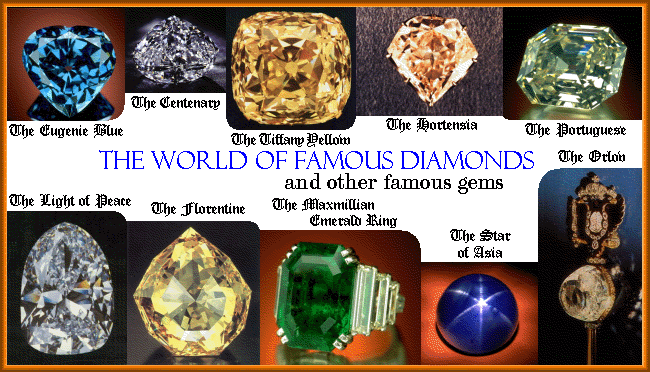
 Kim cương luôn có hấp lực mạnh mẽ đối với con người bởi vẻ đẹp của chúng trùng với khát khao vươn tới của con người: Sự hoàn mỹ và vĩnh cửu. Chính những khát khao ấy đã khiến cho giới sành điệu thích đo lường và xếp loại kim cương.
Kim cương luôn có hấp lực mạnh mẽ đối với con người bởi vẻ đẹp của chúng trùng với khát khao vươn tới của con người: Sự hoàn mỹ và vĩnh cửu. Chính những khát khao ấy đã khiến cho giới sành điệu thích đo lường và xếp loại kim cương.
1. Koh - I - Noor (còn gọi là "Mountain of Light"):
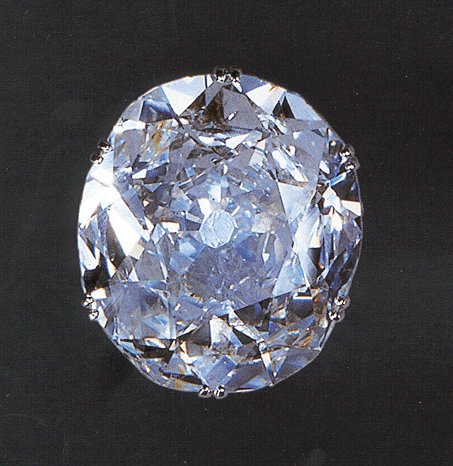
Là một trong những viên kim cương lớn nhất thế giới trọng lượng 186 carats, được phát hiện vào năm 1304.
Viên bảo thạch này được cắt hình oval. Người ta tin rằng nó từng ngự trị trên ngai vàng hình con công của Shah Jahan.
Đến triều đại nữ hoàng Victoria, nó được cắt lại còn 108 carats, trở thành một phần trong kho nữ trang của Hoàng tộc Anh.
2. Cullinan I:
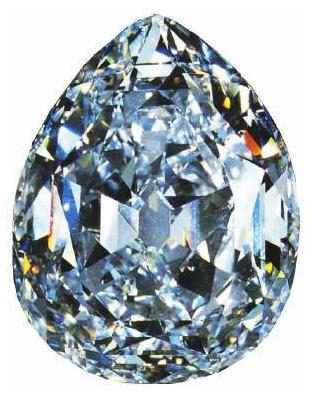
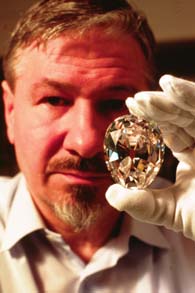
(Còn được gọi là Ngôi sao châu Phi) được đặt tên theo ngài Thomas Cullinan, chủ của công ty khai thác mỏ đã tìm ra nó. Trong số kim cương lớn nhất thế giới, Cullinan I là viên đứng đầu.
Được cắt bởi nghệ nhân Asscher ở Amsterdam, nó có 74 mặt và trọng lượng là 530,20 carats. Cullinan I hiện tại ở Tháp London và trên cây vương trượng của vua Edward VII.
3. Excelsior:
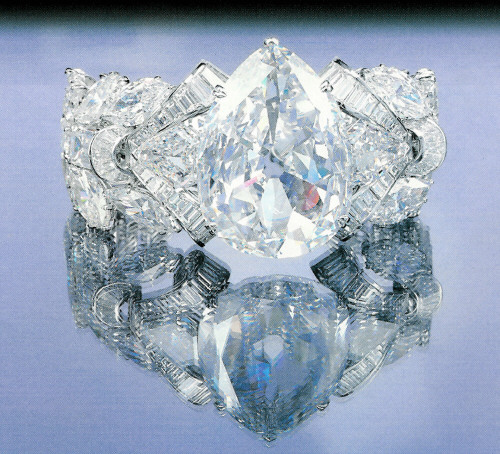
Với trọng lượng ban đầu là 995,2 carats được cắt làm 10 mảnh, trong đó có 3 mảnh lớn nhất có trọng lượng 158, 147 và 130 carats. Những mảnh này được cắt làm 21 viên từ 70 carats đến nhỏ hơn 1 carats.
Một người thợ mỏ châu Phi đã tìm thấy khi anh ta đang chất hàng lên chiếc xe tải. Anh đã giữ bí mật cho đến khi chuyển nó an toàn về tay người quản đốc mỏ để nhận được một ít tiền thưởng, một con ngựa và một cái yên.
4. Orlov:

Viên kim cương lớn thứ 3 của thế giới nặng 194 carats. Orlov (Orloff), một thời bảo vật của thần Sheringham trong điện thờ Brahama, sau đó được sở hữu bởi Shah Nadir, người luôn mong ước có một trong những viên kim cương lớn nhất thế giới. Vào năm 1775, nó được Grigori Orloff trao tặng người tình là nữ hoàng Nga Catherine II và mang tên Orloff kể từ đó.
5. Great Mogul:

Viên kim cương thô được phát hiện vào thế kỷ 17, cân nặng 793 carats và được đặt tên theo Shah Jehan, người xây dựng đền thờ Taj Mahal - một trong những kỳ quan thế giới.
6. Idols Eye:
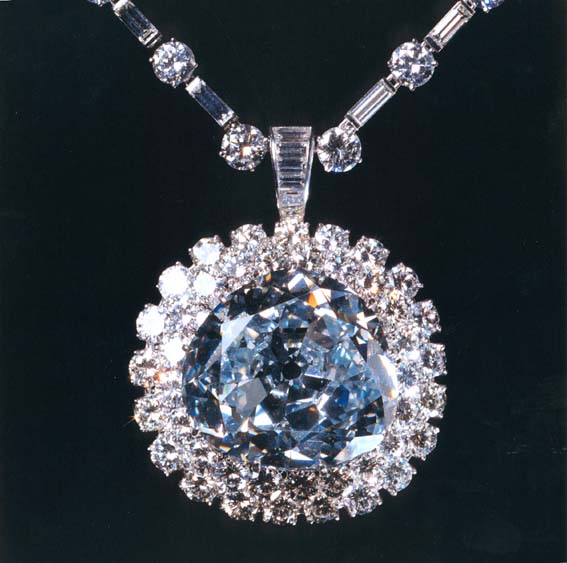
Là một viên kim cương hình trái lê nổi tiếng, trọng lượng của nó khi đã đánh bóng là 70,20 carats. Tên của viên đá xuất phát từ huyền thoại cho rằng trưởng đạo Kahmir đánh cắp nó từ mắt thần trả nợ cho vua Thổ Nhĩ Kỳ, để chuộc công chúa Rasheetah.
7. Sefadu:

Được tìm thấy tại Sierra Leonne vào năm 1970. Lazare Kaplan, một công ty kim cương ở Mỹ sở hữu viên kim cương này. Khi chưa cắt, nó nặng 620 carats và dễ dàng lọt vào danh sách những viên kim cương lớn nhất thế giới.
8. Centenary:
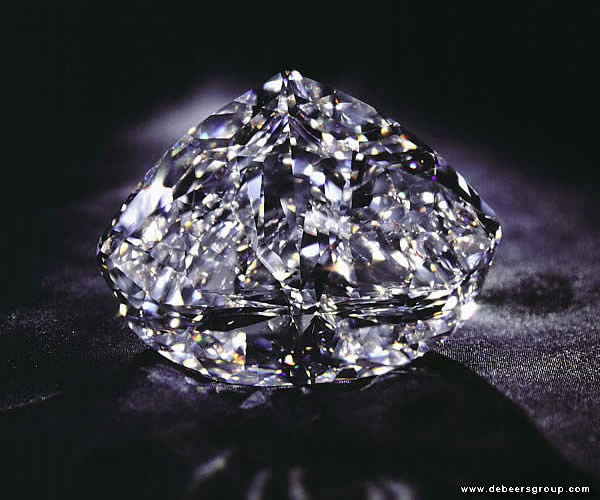
được phát hiện tại mỏ than Premier Mine của Nam Phi vào ngày 17/7/1986 và ngay lập tức được xếp vào nhóm "các ngôi sao" lớn nhất thế giới với trọng lượng 599, 10 carats lúc chưa mài cắt.
Nghệ nhân Gabi Tolkowsky mất 3 năm để hoàn thiện nó thành viên kim cương lớn nhất được cắt gọt hiện đại nhất. "The Centenary" có 75 mặt trên đỉnh, 89 mặt phía dưới và 83 mặt vòng đai, tổng cộng là 247 mặt. Nó nặng 273, 85 carats và hiện tại là một phần trong bộ trang sức của Hoàng gia Anh.
9. Premier Rose:
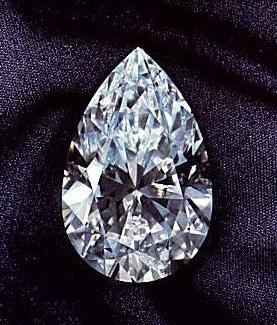
Được xếp vào hàng kim cương lớn nhất khi được phát hiện vào năm 1978, nặng 353, 9 carats. Nó được cắt thành 3 viên và hợp thành nhà họ Premier Rose. Tất cả đều xứng đáng xếp vào hàng những viên kim cương lớn nhất thế giới. Lớn nhất trong 3 viên giữ tên Premier Rose nặng 137, 02 carats, 189 mặt và là viên thứ 2 có hình trái lê lớn thứ 2 trên thế giới. Năm 1979, nó được bán với giá 10 triệu USD.
10. Regent:

Do một nô lệ người Ấn tìm thấy được năm 1701. Lúc chưa mài nó nặng 410 carats. Một thời được sở hữu bởi William Pitt - thủ tướng Anh. Nó được cắt hình nệm, nặng 140, 50 carats. Khi được bán cho Quận công xứ Orleans (Nhiếp chính của Pháp khi Louis XV còn nhỏ) vào năm 1717, nó được gọi tên là "The Pitt".
Sau đó được đổi tên là "The Regent" và đặt trên vương miện của Louis XV trong ngày đăng quang. Sau cách mạng Pháp, nó thuộc về Napoleon Bonaparte. Ông đã cho khảm nó vào chuôi gươm của mình. Bây giờ nó được trưng bày ở điện Louvre như một trong những kỳ tích của thế giới.
11. Blue Hope:
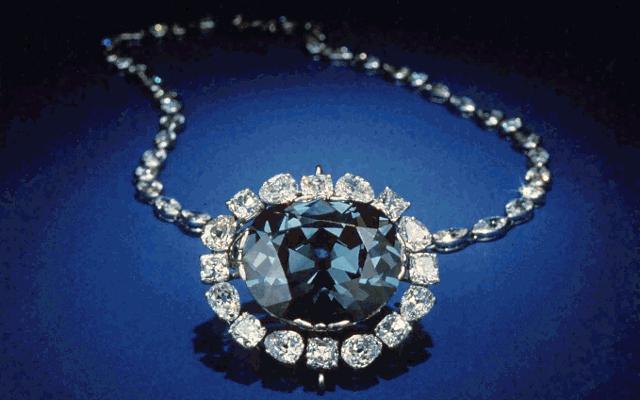
Từng là của vua Louis XIV và được gọi tên là "Viên kim xanh của vương miện". Trong cuộc cách mạng Pháp, nó bị đánh cắp và xuất hiện trở lại vào năm 1830 rồi được mua bởi Henry Philip Hope người London. Viên kim cương được đặt tên theo chủ mới. Người ta tin rằng nó mang lời nguyền bất hạnh cho những ai sở hữu nó. Trong vòng một năm, toàn bộ gia đình của 2 người sở hữu niềm "hy vọng xanh" đã thiệt mạng. Bây giờ nó nằm ở Smithsonian tại Washington.
12. Sancy:
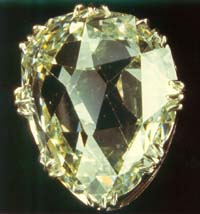
Được đặt tên theo người chủ là Seigneur de Sancy, một đại sứ Pháp tại Thổ Nhĩ Kỳ vào cuối thế kỷ 16. Bắt đầu nó thuộc về Charles the Bold, Quận công xứ Burgundy, đã hy sinh ở chiến trường vào năm 1477. Sancy đem cho vua Pháp, Henry III, mượn để đặt nó trên nón nhằm che đi cái đầu hói. Henry IV của Pháp cũng mượn viên đá này từ Sancy, nhưng sau đó nó được bán cho vua Anh James I vào năm 1664. Đến năm 1688, James II - vua Anh, chạy trốn cùng nó sang Paris và kể từ đó người ta không thấy nó đâu nữa. "The Sancy" nặng 55 carats, thuộc hàng chót của những viên kim cương lớn nhất thế giới.
13. Taylor - Burton:
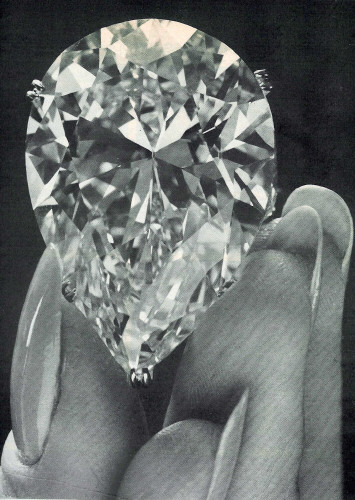
Được tìm thấy ở mỏ than Premier vào năm 1966, nặng 240,80 carats khi chưa mài cắt. Viên kim cương này được Harry Winston mua và cắt nó thành 2 mảnh. Mảnh lớn 162 carats được mài cắt thành hình trái lê còn 69,42 carats. Sau đó được đem đấu giá với giá 1,05 triệu USD và đặt tên là "Cartier". Rồi Richard Burton mua và tặng cho Elizabeth Taylor, từ đó mang tên Taylor - Burton, Elizabeth đưa nó ra để làm qũy xây dựng bệnh viện tại Botswana. Chủ sở hữu hiện tại của nó là Robert Mouawad, chủ tịch tập đoàn Mouawad Group.
(Theo Thời Trang Trẻ)
The World's Most Famous Diamonds
One of my major interests is diamonds, and famous diamonds, and gemology in general. Since there really is no web page dedicated just to famous diamonds, I decided to make this one. This page is strictly for educational purposes. I make no money off this page, and never intend to.
Birthstones
January—Garnet
February—Amethyst
March—Aquamarine or bloodstone
April—Diamond
May—Emerald
June—Moonstone, pearl, or alexandrite (the latter of which changes colors depending on the type of light hitting the stone and in gem quality is considered more valuable than diamond)
July—Ruby
August—Peridot or sardonyx
September—Sapphire
October—Opal or tourmaline
November—Topaz or citrine
December—Turquoise or zircon
If you read any of the captions, you might wonder what a carat is. Gemstones are measured in carats (not carrot). 142 carats is equal to one ounce. The old carat measurement was slightly more than the new carat. When I say old, I mean several hundred years ago...
Gold is measured in karats. For instance, 24 K gold means that 24 of the 24 parts of the metal are gold. 18 K means that 18 parts of the 24 are gold. (See the FAQ section.)
First, a little walk-through on the diamond subject so this page makes more sense. :)
The Four C's
Color Diamond color is graded on a scale of the alphabet, using letters D through Z. The letters A, B, and C aren't used. This is because when the Gemological Institute of America invented the scale they wanted to disassociate it from jewelry stores that used their own color grade scales. The colors D, E, and F are considered to be completely colorless. D is of course, the best. Some famous diamonds are actually leaning towards the Z end of the scale but aren't quite "Fancy colored", like the faint yellow 55-carat Sancy Diamond. The largest known D-color diamond in the world is the Centenary, which weighs 273.85 carats. The second largest is probably the Millennium Star, which weighs 203.04 carats. Some diamonds do not fit onto the scale, such as fancy colored diamonds. Diamonds occur in every color of the rainbow. The rarest colors are red and purple, and combinations of those two colors. Yellow and brown are the most common color of diamond, but colorless is the most popular as far as jewelry is concerned. (Colored diamonds are very gradually appearing in more and more jewelry stores as they become more well-known.) Blues and greens are very rare, especially naturally colored stones. Some lightly colored diamonds (light light pink, light light blue, ect.) are irradiated to make their color more intense. This means that low fields of radiation are beamed into the cut and polished stone, darkening the outer part of the stone all the way around. The process is permanent and professionally accepted in the diamond industry. Probably the largest irradiated diamond is the Deepdene, a 104.88-carat golden yellow cushion shaped stone.
Faint*
Very Light*
Light*
Fancy Light
Fancy
Fancy Intense
Fancy Vivid
*May fall into the lower end of the D-Z scale.

This is the color scale for brown diamonds with no secondary colors.
There are essentially 7 degrees of color intensity for brown.

The color scale for colorless to near-colorless diamonds.
A natural fancy colored diamond will cost you much much more than an irradiated one. Such well known diamonds as the Hope, the Dresden Green, the Tiffany Yellow, the Conde Pink, and Sultan of Morocco, the Transvaal Blue, the Wittelsbach, the Agra, and the Great Chrysanthemum are all very very unique because they were not irradiated. One remarkable stone, the Dresden Green, stands out amoung the naturals. It is the largest green diamond in the world at 40.70 carats. The fact it is an historic diamond, quite large and a natural green color with a slight blue overtone makes it virtually priceless. The Hope is also very unusual for the same reasons, but much more famous. The stone was originally a rather flat, blocky 110-carat rough. It was cut into a triangular pear of 68 carats, and then again into the 45.52-carat cushion cut it is today. The Conde Pink is a pear shaped 9.01-carat pink stone once owned by Louis XIII, also a naturally colored diamond. In January, 2002, I recieved an email from Terry J. Murray, in which he told me the following about a red diamond that had been auctioned off at Christies Auction House: "A rectangular-cut fancy red diamond of 0.73 carats sold for $536,000 per-carat." This was in a May 2nd, 2001 press release on the site. Thanks Terry! :)
In 1988, Sotheby's Auction House also sold a round, 0.90-carat, VS2 clarity, vivid green of natural color for $663,000 to an American collector. The per-carat price was over $736,000. This per-carat price is second to the 0.95-carat Hancock Red Diamond that sold also at Sotheby's for $880,000 (or $926,315 per-carat) on April 28, 1987. The stone is rumored to have been bought by a man representing the Sultan of Brunei, who is said to have one of the largest colored diamond collections in the world. All in all, a colored diamond is going to cost more than a colorless one, but colorless diamonds will probably always be more popular in the market.
Clarity Diamond clarity is measured on a scale of I3 to FL. These are short for Imperfect 3 and Flawless. I3 (imperfect, eye visible inclusions), I2 (imperfect, eye visible inclusions), and I1 (imperfect, eye visible inclusions). I3 is the worst one the scale. It's so included that it looks like there is a cottonball trapped inside the diamond. Then higher up on the scale is SI2 (slight inclusions), and SI1 (slight inclusions). Many SI diamonds that are finely cut may look alot better than their clarity calls for. VS2 and VS1 are the next on the scale, standing for very small inclusions. Both the Hope and the Tiffany Yellow Diamond are of VS1 in clarity. VVS1 and VVS2 stand for very very small inclusions. The 137-carat Light of Peace is a VVS1 in clarity and a D in color.
IF stands for internally flawless, and then FL, which stands for flawless. In your everyday jewelry store, an interally flawless diamond is unusual. D, E, and F-color diamonds are fairly common, especially smaller ones. A combination of D-color and Internally Flawless is rare, and therefore more expensive. The two largest faceted D-Internally Flawless diamonds that I know of are the 273.85-carat Centenary Diamond and the 203.04-carat Millenium Star Diamond. The largest Internally Flawless diamond is the Incomparable, which is a 407-carat Fancy Brownish-Yellow "triolette" shape. Flawless diamonds are quite rare. The highest grade one usually sees is Interally Flawless. You could search the world for a Flawless diamond but there wouldn't be much point -- an Internally Flawless would essentially be just as good. The only difference is an Internally Flawless diamond is allowed to have 'naturals', which are unpolished surfaces of the original diamond crystal still remaining on the finished gem. They are usually small and hidden from view on the pavilion side of the stone, up near the girdle. They tend to have a glassy (but not polished) look, sometimes showing 'trigons', which are triangular depressions characteristic of many diamond crystals. As long as that aren't visible in the face-up diamond, they don't affect the clarity grade. However, they can't be present in a diamond for it to receive a Flawless grading.
Cut There are many many different types of diamond cuts. The most common is the round brilliant, which has 57 facets. There are several very common variations on the round brilliant - the oval, the marquise, some cushion cuts, and the pear. All of which, in standard form, have 57 facets. Other very common diamond cuts are the heart, the step, and the princess. The sky is the limit as far as diamond cuts go. The last I heard, there are 255 registered diamond cuts.
However, the ones I just mentioned are the most common because some exotic cuts can waste rough stone. Heart cuts have become very popular the past few years, partly because of the booming diamond industry, and the film "Titanic", which featured a large heart cut blue sapphire that was thrown into the ocean. The movie prop was fake. However, after the film's release, a jewelry company faceted a heart cut sapphire identical to the stone in the film, then mounted it in a necklace to match. People often confuse the Hope Diamond and the 'Heart of Ocean' - both were blue, and both were surrounded by smaller white stones. However, one is a heart cut and the other a cushion, and the 'Heart of the Ocean' is considerably larger than the Hope Diamond. I am perpetually irritated by people confusing the Hope with the 'Heart of the Ocean.'
Carat-Weight Carat weight is the most deciding factor as to the value of a diamond. A well cut diamond of SI1 clarity and a weight of 4.00 carats would be worth alot more than one of the same clarity, but weighing 1.60 carats and VS2 clarity.
The largest faceted diamond in the world is the Golden Jubilee, weighing 545.67 carats. It is a Fancy Brownish-Yellow color and "fire rose cushion cut." It is unusual also because it has a certain type of rare color banding. The second largest faceted diamond in the world is the Star of Africa, also known as the Cullinan I. It weighs 530.20 carats and is a pear shape with 74 facets. The third largest diamond in the world is the Incomparable. It is a golden yellow-orange color, pear shaped, and weighs 407 carats. The fourth largest faceted diamond in the world is the Cullinan II. It was cut from the same stone as the Star of Africa - aka Cullinan I. It weighs 317.40 carats and is a cushion cut.
Up until 2001, the most valuable diamond (price-per-carat) was the 0.95-carat fancy red Hancock Red that had been sold at auction at Christies, NYC, for $880,000 ($926,315 per-carat). The stone was apparently purchased by a buyer representing the Sultan of Brunei, who reputedly has one of the largest collections of fancy colored diamonds in the world. I am not exactly sure which diamond holds the world record for the highest price per-carat, but I am almost certain its no longer held by the Hancock Red. Time will tell!
If you find any typos on the page, please email me and I'll correct them. I had to unlink my email address due to the amount of spam I get from internet-roaming spambots. ragemanchoo at hotmail.com is the address. (Hotmail doesn't exactly care to curb the spam the way Yahoo Mail does with their "This is Spam" button.) Thanks! :)
The Blue Heart (sometimes called the Eugénie Blue)
The Condé (Sometimes called the Condé Pink or Le Grand Condé)
The De Beers (and the recently rediscovered Patiala Necklace)
The Florentine (replica cut by Scott Sucher)
The Graff Unnamed Asscher Cut Diamond ring As seen in their ads in the New York Times.
The Graff Unnamed Blue (Not to be confused with the Graff Imperial Blue, a stone with I am still researching)
The Graff Unnamed Cushion Cut Diamond ring Also seen in their NY Times ads...
The Moussaieff Red (formerly known as the Red Shield)
The Orlov (sometimes spelled 'Orloff')
The Russian Crown Jewels (Includes the Shah Diamond - the Orlov was moved to its own section, see above)
The Spoonmaker's (also known as the Kasikci)
The Victoria (sometimes called the Jacob)
Noteworthy Unnamed Diamonds
An Unnamed 81-carat Emerald Cut D-VS1 Diamond
An Unnamed 63-carat Oval D-FL Diamond
An Unnamed 56-carat Pear-Shaped D-IF Diamond
An Unnamed 37-carat Cushion-Shaped Fancy Light Yellow Diamond
An Unnamed 20-carat Fancy Vivid Yellow Oval Brilliant Diamond
An Unnamed 27-carat Pear Shape Fancy Dark Yellowish-Brown Diamond
Major Pieces of the Diamond Collection of Janice H. Levin
A Letter from Gabrielle Tolkowsky I wrote to him via good old-fashioned "snail mail" around Thanksgiving of 2001. This was his reply. :)

CZ replica of the Porter Rhodes
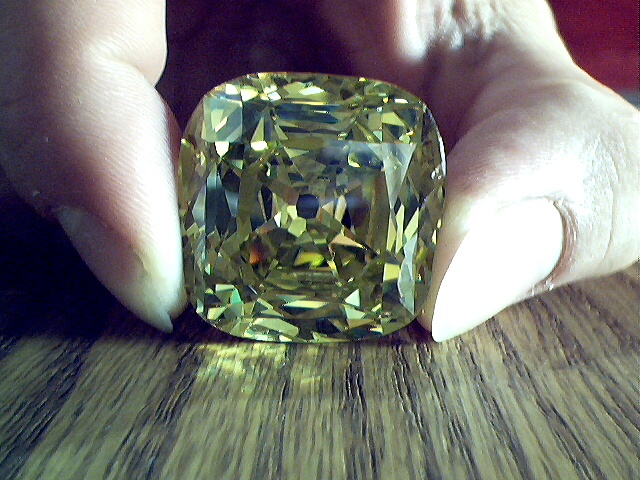
CZ replica of the Tiffany Yellow
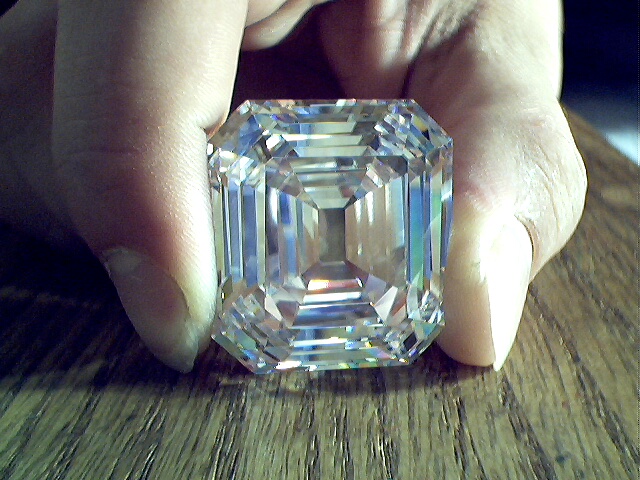
CZ replica of the Jonker (pronounced 'Yonker')
A replica of the Porter Rhodes Diamond, and a replica of the Tiffany Yellow Diamond, both cut from cubic zirconia. I got them from NW Diamonds & Gems. I had the Porter Rhodes replica set in a silver pendant and gave it to my grandmother in November of 2003. The Tiffany Yellow replica is so large that I am going to have to make my own setting for it from scratch. It will be fun! :) The stone measures 28 × 28 mm, so it would be futile to try and find a setting to hold a cushion-shaped gem that size. NW D&G had one other replica of the stone, identical to mine, but it sold. They have a batch of orangey-yellow replicas now, but I think their color is too distant from that of the actual Tiffany Yellow. In April, 2004 I got a replica of the Jonker from them, pictured above. The stone was intended to be a replica of the Portuguese Diamond but when the replicas arrived, they turned out to be much more like the Jonker in proportions.
A group of multi-colored diamonds A group of three blues, three browns, two yellows, and an orange. Big file.. 250k.
Another group of multi-coloreds Yellows, browns, some blues, oranges, and several more shades, totalling 21 diamonds.
The Texas Faceters Guild along with a few other people scattered around the world are working on retro-engineering famous diamond facet layouts into Gemcad so replicas of them can be cut. Of the diamonds they have already 'completed', among them are the Hope, Dresden Green, Incomparable, the nine Cullinan Diamonds, the Florentine, and several others. I have these Gemcad files, if you would like any/all of them, please email me at ragemanchoo (at) hotmail.com
Famous Diamond Replicas These stones were cut out of cubic zirconium by Scott Sucher. The photo is © Lapidary Journal and is not to be reproduced. Many of the diamonds shown in this photo are shown elsewhere on this page. The stones in this picture are Cullinans I through IX, the Tiffany Yellow, the Dresden Green, the Hope, the Sancy, the Dudley (aka Star of South Africa), the Pasha, and the Florentine. Please contact www.lapidaryjournal.com if you'd like to subscribe to their magazine or ask them any questions. If you need cubic zirconium rough, try some of the following sites (Morion and Megalogs also sell YAG material ... Morion has photos of the rough and cut CZ they offer):
www.alpha-supply.com
www.morioncompany.com
www.megalogs.com
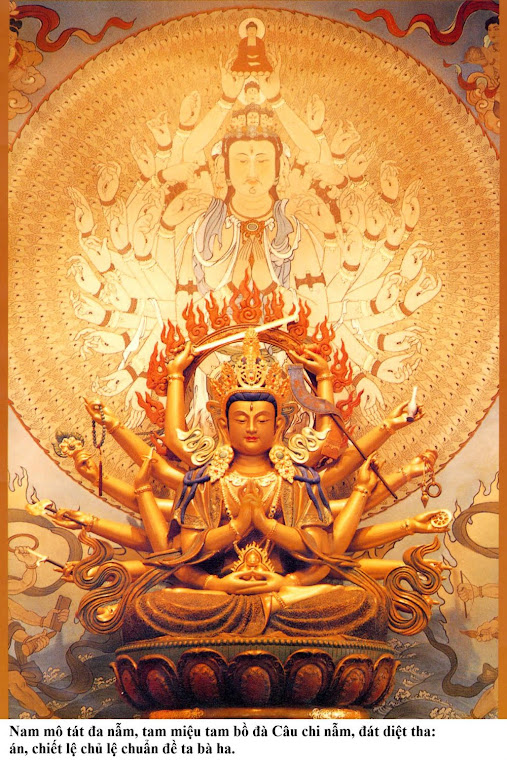
No comments:
Post a Comment